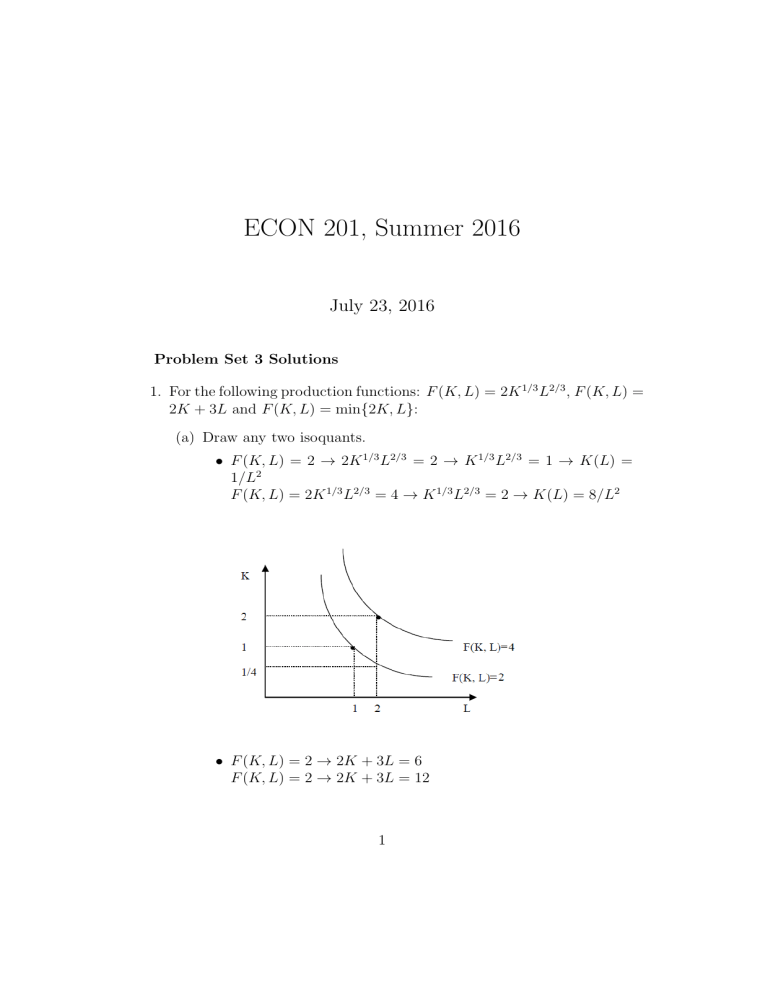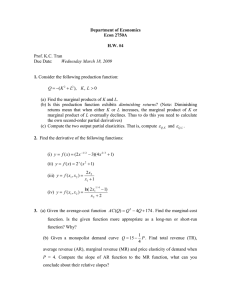
ECON 201, Summer 2016
July 23, 2016
Problem Set 3 Solutions
1. For the following production functions: F (K, L) = 2K 1/3 L2/3 , F (K, L) =
2K + 3L and F (K, L) = min{2K, L}:
(a) Draw any two isoquants.
• F (K, L) = 2 ! 2K 1/3 L2/3 = 2 ! K 1/3 L2/3 = 1 ! K(L) =
1/L2
F (K, L) = 2K 1/3 L2/3 = 4 ! K 1/3 L2/3 = 2 ! K(L) = 8/L2
• F (K, L) = 2 ! 2K + 3L = 6
F (K, L) = 2 ! 2K + 3L = 12
1
• F (K, L) = 2 ! min{2K, L} = 2
F (K, L) = 4 ! min{2K, L} = 4
(b) Find whether they have diminishing, constant or increasing returns to labor.
• M PL = 2K 1/3 L1/3
Taking the derivative of the marginal product of labor, we get
@M PL
< 0. Therefore, there is decreasing marginal returns
@L
to labor.
• M PL = 3, taking the derivative of the marginal product of
@M PL
labor we get
= 0. Therefore, there is constant returns
@L
to labor.
2
•
M PL =
(
1 if 2K L
0 if 2K < L
and
@M PL
=
@L
(
0 if 2K L
0 if 2K < L
Therefore, this production function exhibits constant returns
to labor.
(c) Find whether they have diminishing, constant or increasing returns to scale.
• For ↵ > 1, we have
F (↵K, ↵L) = 2(↵K)1/3 (↵L)2/3 = 2↵K 1/3 L2/3 = ↵F (K, L)
Therefore, this production function exhibits constant returns
to scale.
• For ↵ > 0, we have
F (↵K, ↵L) = 2↵K + 3↵L = ↵(2K + 3L) = ↵F (K, L)
Therefore, this production function exhibits constant returns
to scale.
•
F (↵K, ↵L) = min{2↵K, ↵L} = ↵ min{2K, L} = ↵F (K, L)
Therefore, this production function also exhibits constant returns to scale.
(d) Compute the marginal product of input 1 for x2 = 10 and x1 = 4.
• M PK = (2/3)K
• M PK = 2
2/3
L1/3 = 2/3(4)
3
2/3
(10)2/3
• With (K, L) = (4, 10), we have F (K, L) = 8. When we increase the amount of kapital by one unit, i.e., (K, L) = (5, 10),
we have F (K, L) = 10. Therefore M PK = 2 at this point.
You can also check the marginal production function, i.e:
(
2 if 2K < L
M PK =
0 if 2K L
and we already know that 2K < L at (4, 10).
(e) Compute the marginal product of input 1 for x2 = 10 and x1 = 6
• M PK = (2/3)K 2/3 L1/3 = 2/3(6) 2/3 (10)2/3
• M PK = 2
• With (K, L) = (6, 10), we have F (K, L) = 10. When we
increase the amount of kapital by one unit, i.e., (K, L) =
(7, 10), we have F (K, L) = 10. Therefore M PK = 0 at this
point. You can also check the marginal production function,
i.e:
(
2 if 2K < L
M PK =
0 if 2K L
and we already know that 2K
L at (6, 10).
(f) Now assume that the price per capital is r and the price per labour
is w. Calculate the long-run cost functions for each production
function. Find also the average and marginal costs.
• F (K, L) = 2K 1/3 L2/3 , from the optimality condition:
M PL
2K
w
=
=
M PK
L
r
2Kr
L=
w
then let F (K, L) = X,
X =2K 1/3 (
2Kr 2/3
2r
) = 2( )2/3 K
w
w
1 2r
K(X) = ( ) 2/3 X
2 w
2rK(x)
1 2r
L(X) =
= ( )1/3 X
w
2 w
4
then we find the total cost:
C(X) = wL(X) + rK(X)
1 2r
1 2r
= w ( )1/3 X + r ( ) 2/3 X
2 w
2 w
2/3 1/3
2/3
= w r (2
+ 2 5/3 )X
Moreover, we know that AC(X) = C(X)/X and M C(X) =
@C(X)
. In particular, in this case AC(X) = M C(X)
@X
AC(X) = M C(X) = w2/3 r1/3 (2
2/3
+2
5/3
)
• F (K, L) = 2K + 3L. From the optimality condition we have:
M PL
3
=
M PK
2
w
3
< , then it is optimal to use only L, i.e.,
r
2
L(X) = X/3 and K(X) = 0.
w
3
If > then it is optimal to use only K, i.e., L(X) = 0 and
r
2
K(X) = X/2.
w
3
If
=
then any combination is optimal, i.e., L(X) =
r
2
X
(X 2a)/3 and K(X) = 2a where a 2 [0, ]. Therefore,
2
8
wX
w
3
>
>
if
>
< 3
r
2
C(X) =
>
>
>
: rX if w > 3
2
r
2
w r
in other words, C(X) = min{ , }X and
3 2
w r
AC(X) = min{ , }
3 2
8
w
3
>
>
w/3 if
>
<
r
2
M C(X) =
>
>
>
:r/2 if w > 3
r
2
This implies if
5
• F (K, L) = min{2K, L} ! 2K = L ! X = 2K Therefore we
X
have K(X) =
and L(X) = X. Then
2
X
r
C(X) = wX + r = (w + )X
2
2
r
AC(X) = M C(X) = w +
2
p
2. A firm has a production function f (x1 , x2 ) = x1 x2 . Prices are as
follows: p = 5 for the output, and w1 = 1 and w2 = 2 for the inputs.
The amount of input 2 is fixed at x2 = 4 and can not be changed.
(a) Compute the profit maximizing choice of inputs and output.
⇡ = pf (x1 , x2 ) c(x1 , x2 )
p
= 5 4x1 x1 8
p
= 10 x1 x1 8
Taking derivative with respect to y, we have
10
=0
p
2 x1 1
p
then, when we solve for x1 , we find x⇤1 = 25 and y = 25.4 = 10
(b) Compute profits. Substitute the optimal levels in to the profit
function:
⇡ = 5.10
25
8 = 17
3. Consider a firm with the same production function of question 2. Suppose that the firm wants to produce 40 units of output. If w1 = 40 and
w2 = 10, what is the cost minimizing input levels that will produce
these 40 units?
From the optimality condition, we have
x1
w1
T RS =
=
x2
w2
40
x1
=
=4
x2
10
x⇤1 = 4x⇤2
6
then we need to substitute this into the production function to find the
exact values:
p
x1 x2
p
= 4x⇤2 x2 = 2x⇤2 = 40
y = f (x1 , x2 ) =
We have x⇤1 = 80 and x⇤2 = 20.
4. All tobacco producers in Indonesia have the following cost function
(both in the short-run and in the long-run): C(x) = 8 + (1/8)x2 when
x > 0, and C(0) = 0. Assume that there is pure competition and the
demand function for tobacco is D(p) = 72 16p, where p denotes the
price of tobacco.
(a) Find the industry’s short-run supply function if there are four
firms.
x
4
8 x
AC(x) = +
x 8
M C(x) =
We know that M C(x) = AC(x), then x⇤ = 8 and p⇤ = 2. Therefore, we have the following
8
>
<0 if p < 2
Xi (p) = {0, 8} if p = 2
>
:
4p if p > 2
8
>
<0 if p < 2
X(p) = {0, 8, 16, 24, 32} if p = 2
>
:
16p if p > 2
7
(b) Find the long-run competitive equilibrium price, per firm output,
industry output, and number of firms.
We already know that Xi⇤ = 8 and p2 = 2. Then D(2) = 72 16 ⇤
2 = 40 and n⇤ = 40/8 = 5. In the long run, there will be 5 firms
in the market for tobacco.
5. Find under which conditions, i.e. for what values of a, b and c the following production functions exhibit increasing,constant and decreasing
returns to scale, where a, b and c > 0.
(a) F (K, L) = cK a Lb
F (↵K, ↵L) = c(↵K a )(↵Lb )
= ↵a+b cK a Lb = ↵a+b F (K, L)
If a + b < 1, then this function exhibits diminishing returns to
scale.
If a + b = 1, then this function exhibits constant returns to scale.
If a + b > 1, then this function exhibits increasing returns to scale.
(b) F (K, L) = min{aK, bL}
F (↵K, ↵L) = min{↵aK, ↵bL} = ↵ min{aK, bL} = ↵F (K, L)
For any value of a and b, this production function exhibits constant
returns to scale.
8
(c) F (K, L) = c(aK + bL)
F (↵K, ↵L) = c(↵aK + ↵bL) = ↵c(aK + bL) = ↵F (K, L)
For any value of a,b and c, this production function exhibits constant returns to scale.
6.
• 22.2 The cost function given as c(y) = y 3
8y 2 + 30y + 5
(a) M C(y) = 3y 2 16y + 30
(b) AV C(y) = y 2 8y + 30
(c) The graph is as follows:
(d) Average variable cost is falling as output rises if output is less
than 4 and rising as output rises if output is greater than 4
(You can find this threshold value by finding the minimum of
average variable cost).
(e) Marginal cost equals to average variable cost when output is
4.
9
(f) The firm will supply 0 output if price is less than 14 (Substitute y = 4 into the marginal cost function)
(g) The smallest positive amount that the firm is ever supply at
any price is 4. At what price the firm supply exactly 6 units of
output? p=42 (Substitute 6 into the marginal cost function).
• 23.8 Suppose all firms in a given industry have the same supply
curve given by Si (p) = p/2. Plot and label the 4 industry supply curves generated by these firms if there are 1,2,3 or 4 firms
operating in the industry.
(a) If all the firms had a cost structre such that if the price was
below $3, they would be losing money, what would be the
equilibrium price and output in the industry if the market
demand was equal to D(p) = 3.5?
p
3.5p = n
2
7
=n
p
10
and we know that p > 3, therefore we have 3.5 and n = 2.
The out put in the industry would be 3.5.
(b) What if the identical conditions as above held except that the
market demand was equal to D(p) = 8 p? Now what would
be the equilibrium price and output? How many firms would
operate in such a market?
8
16
p=
pn
2
16
>3
2+n
! 16 > 6 + 3n ! 10 > 3n
2p = pn ! p =
Therefore, we conclude that n = 3, p = 3.2 and output is
8 3.2 = 4.8
11







